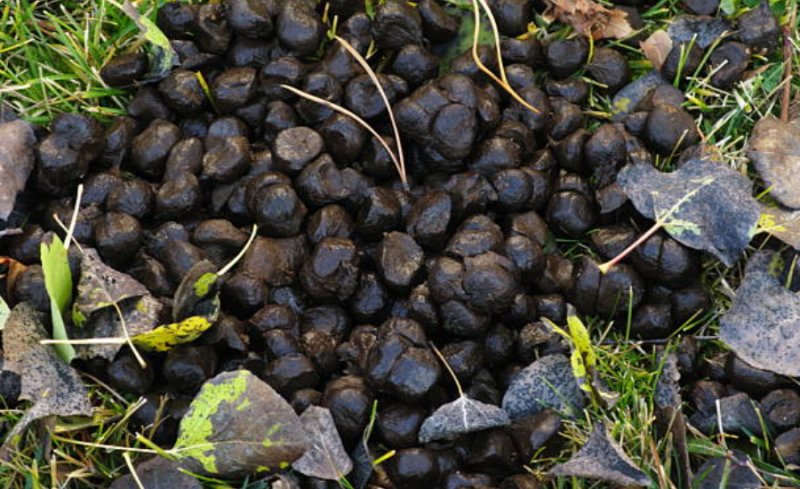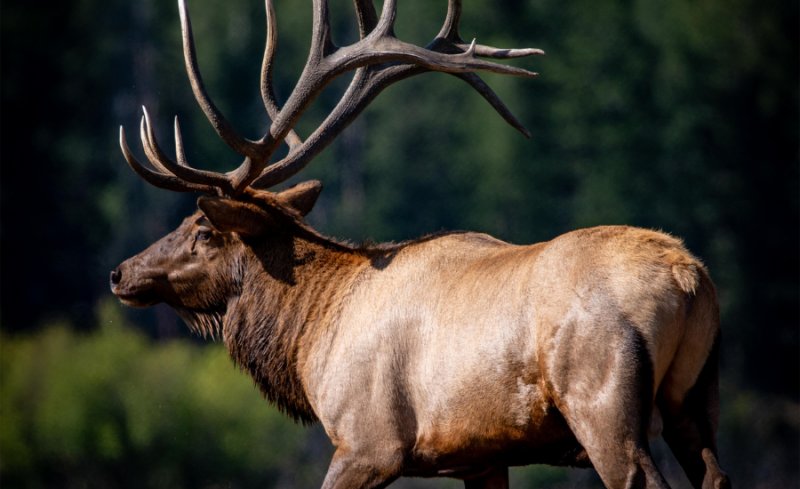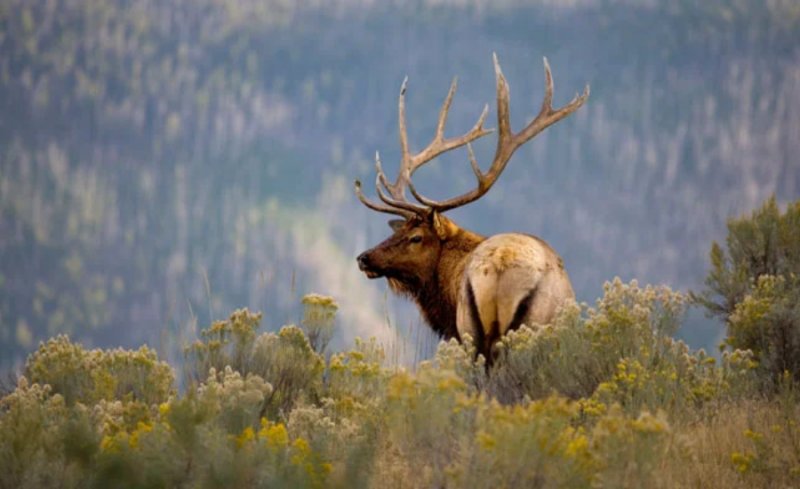Elk Poop: Unraveling Nature’s Hidden Clue
Elk, majestic and awe-inspiring creatures, roam the vast landscapes of various ecosystems. As they traverse forests, grasslands, and mountainous regions, they leave behind intriguing clues of their presence – their poop! While it may not be the most glamorous topic, elk poop, scientifically known as scat, plays a vital role in the natural world.
Hint will study elk dung and its importance in understanding these wonderful animals and their environments in this post. From unraveling the secrets hidden within their droppings to examining their impact on the environment, we will journey through the scientific and ecological aspects of elk scat.
Beyond just being wildlife waste, elk poop offers valuable insights into their diet, behavior, and overall health. It also aids nutrient cycling and seed distribution in the complex web of life. We will also discover how this seemingly ordinary substance can provide essential information for conservation efforts and environmental monitoring.
Moreover, elk poop holds historical and cultural significance, having been utilized in various traditional practices throughout human history. Even in the modern world, it finds applications that might surprise you. Join us as we explore the unique uses of elk poop and the interesting stories it weaves through art, literature, and popular culture.
Elk dung is crucial to understanding the health of the elk population and their ecology. This post will make you appreciate nature’s hidden stories, even in scat. Let’s explore elk poop’s mysteries.
What Do Elk Eat?
Just like many other animals, an elk’s poop is influenced by its diet. Elks are omnivorous. Their primary diet consists of grass, but they also consume forbs (herbaceous flowering plants) and tree barks. In addition to plant-based foods, elks also enjoy eating animal sources such as bird eggs, antlers, and bones.
They eat timothy grass, blue grass, wheatgrass, willow, aspen, rowan, and birch twigs. Elk consume fescue, dandelions, willow, violets, elk thistle, acorns, heather, lichen, bird bones, goslings, white clover, and more. During the winter, when their usual food sources may be scarce, elks adapt by including cattails, junipers, and less nutritious grasses in their diet.

Elks have a unique digestive system as they are ruminants. This means they have multi-chambered stomachs that help them properly digest their food. They practice a process called regurgitation and chewing cud, which allows them to break down their food further and extract more nutrients. Elk calves survive on their mother’s milk for a month before switching to grass and other foods.
Understanding Elk Habits and Digestion
Elk are beautiful creatures with spectacular antlers. Explore their routines and learn how digestion affects their behavior and survival in their natural settings to appreciate these amazing creatures.
Diet, social structure, and environment affect elk behavior. These herbivores eat what’s available in their environment. In summer, they eat grasses, sedges, and forbs. Elk eat bushes and tree saplings to survive tougher conditions when seasons change and plant supply fluctuates.
Elk create herds to survive winter. These social systems guard against predators and provide help amid scarcity. Bulls maintain their dominance and mating privileges during the fall rutting season.
Elk’s diverse food requires a strong digestive system. Elk, like other ruminants, have a four-chambered stomach to break down and absorb nutrients from plants. They start by eating lots of grass. They chew the cud—partially digested food—later. Re-swallowed cud enters the stomach’s remaining chambers for fermentation and nutritional extraction.

Elk may live in varied locations because their complicated digestive process extracts nutrients from fibrous plant components. As herbivores, their ability to switch food sources based on availability shows their versatility and resilience.
Elk habits and digestive prowess are intricately linked, revealing their survival strategies and environmental influence. By understanding the delicate balance between their diet and environment, we can better appreciate these amazing animals’ role in conserving biodiversity.
Anatomy of Elk Poop
Elk poop, or scat, may not be beautiful, but it can reveal a lot about these majestic animals and their role in ecology. Let’s examine elk dung anatomy to discover its mysteries.
Elk scat’s size and texture depend on its age, sex, and food. It is cylindrical or pellet-like with a half-inch to one-inch diameter. Depending on the elk’s digestive process and food, its scat can be several inches long.
Fresh elk scat is moist and velvety, making it easier to see. Exposure to the elements and drying allows the scat to harden and disintegrate, eventually merging with the environment.
Elk excrement reveals their diet and how they assimilate plants. Elk, herbivores, eat grasses, bushes, and tree leaves. Their poop is plant stuff.
Elk scat helps the ecology cycle nutrients, despite its unpleasant taste. Scat decomposes, releasing plant nutrients into the soil and encouraging new plant growth. This mechanism maintains the fragile environmental balance, benefiting other animals and plants.
Elk behavior, diet, and health can be learned by studying elk dung anatomy. Scientists can learn about elk health, habitat preferences, and adaptation by studying their scat.
Elk scat helps wildlife biologists track elk populations and measure their impact. Elk scat, a vital part of the food web, shows the ecological health of their habitats.
Elk feces may not be attractive, but it is a tremendous resource for understanding these majestic creatures and recognizing their vital role in the circle of life.
Is Elk Poop Dangerous?

The safety of elk poop depends on the context in which it’s considered. Elk excrement contains essential nutrients for plant growth. However, elk excrement may be harmful to humans.
Animal and human intestinal germs are in elk scat. Microorganisms are mostly harmless. E. coli causes life-threatening urinary tract infections.
Be careful around water sources since elk dung may contain enteric germs. If humans consume water contaminated by elk poop, they may face significant health challenges. Thus, handling elk scat requires particular attention.
Moreover, elk poop can also pose a threat to other animals. Elk and deer populations are known to be susceptible to Chronic Wasting Disease (CWD), a fatal condition. There is concern that this disease can spread to other animals through the infected elk’s poop. While it’s not entirely clear if CWD can spread to humans, it remains a possibility that needs to be taken seriously.
Elk dung may be good for plants but dangerous to humans owing to bacteria. Additionally, it could potentially transmit dangerous diseases to other animals. Being cautious and taking preventive measures when dealing with elk scat is essential to ensure the safety of both humans and wildlife.
Anatomy of Elk Poop
Elk dung, albeit unpleasant, is important in nature. Scat from majestic elk reveals intriguing life details. Depending on age, sex, and food, elk dung (scat) is different shapes and sizes. It usually appears as cylindrical pellets from half an inch to an inch. The elk’s digestion and diet determine the scat’s length, which can be several inches. Elk scat is easier to spot in the wild when fresh and damp. The scat eventually dries and breaks down, integrating into the environment.

Elk excrement reveals food and digestion. Elk, herbivores, eat grasses, bushes, and tree leaves. Their scat is mostly undigested plant stuff. This common waste is vital to the ecosystem. Elk scat plants seeds while they graze. This natural process helps plant species propagate, increasing biodiversity. Elk scat also helps cycle nutrients. Scat decomposes, releasing plant nutrients into the soil and feeding other plants. This maintains the delicate environment and supports species dependent on those plants.
To understand elk behavior, food, and health, scientists and wildlife professionals investigate their dung. They can estimate elk population health and environmental factors by studying scat. Elk dung anatomy reveals much about these wonderful creatures and their environment. It reminds us of the interconnectivity of nature and the complicated web of life in which every element, no matter how small, is important.
The Science of Elk Poop
Beyond its initial unappealing appearance, elk poop, or scat, holds a wealth of scientific information that goes far beyond what meets the eye. For researchers and wildlife enthusiasts, elk scat serves as a valuable source of knowledge about these magnificent animals and the ecosystems they inhabit.
Elk dung provides data about elk health and behavior. Scat analysis can reveal the elk’s diet, nutritional intake, and environmental adaptations. Elk populations and habitats depend on this information for wildlife management and conservation.
Elk scat also plays an essential role in seed dispersal, contributing to the growth and diversity of plant species in their ecosystem. As elk graze on vegetation, they unintentionally transport seeds in their digestive system, which are later deposited through their scat in various locations. This natural process aids in the regeneration of plant life and maintains the balance of the ecosystem.
Moreover, scientists can examine elk scat to assess the presence of parasites, diseases, and other health indicators within the elk population. By studying scat samples, researchers can monitor the overall health of elk herds and identify potential threats to their well-being, which is crucial for managing wildlife diseases and mitigating any risks.
Elk excrement science offers insight into these gorgeous animals and their complex habitats. From understanding their diet and behavior to their impact on the environment, elk scat continues to be a valuable tool for advancing wildlife research and conservation efforts.
The Journey of Elk Poop in the Environment
Elk dung, or scat, travels far after these majestic animals drop it in their natural environments. The ecosystem’s equilibrium and environmental health depend on these common waste changes. Elk defecate on the ground, leaving it vulnerable to weather and predators. Scat decomposes over time. In this phase, bacteria, fungi, and insects break down organic matter into simpler compounds.
Scat decomposes to replenish soil nutrients. These minerals nourish the soil and promote local plant growth. The nutrient cycle promotes a healthy ecosystem by feeding plants, insects, and other animals. Elk scat also helps spread seeds. Elk accidentally eat seeds, which survive digestion and are excreted in their poop. This process spreads seeds over the ecosystem.

Elk scat also feeds insects, rats, and birds. It is a crucial part of the food chain, sustaining many wildlife species and showing the interdependence of nature.
Elk poop’s trip through the ecosystem is fascinating and vital. Elk scat shows nature’s incredible capacity to recycle and use resources efficiently, balancing the environment by nourishing the soil, dispersing seeds, and feeding wildlife.
Unique Uses of Elk Poop in Human History
Throughout human history, elk poop has found diverse and surprising applications that highlight the resourcefulness and ingenuity of our ancestors. Though it might sound unconventional, people in various cultures have recognized the value of elk scat and creatively incorporated it into their daily lives.
In many indigenous cultures, elk poop served as a valuable source of fuel. Dried elk scat was used as an efficient and readily available material for starting fires. When other fuel sources were scarce, such as during harsh winters or in remote regions, people relied on these dried dung patties to keep their hearths warm and their homes comfortable.
Beyond its practical uses, elk poop also held cultural significance for certain communities. In some native traditions, elk scat was considered a symbol of fertility and prosperity. It was believed that scattering dried scat in fields or gardens could bring forth bountiful harvests and ensure the land’s fertility.
Moreover, historical records reveal intriguing medicinal uses of elk scat in ancient folk remedies. Some herbalists and healers employed elk poop as an ingredient in traditional medicines, believing it possessed healing properties for certain ailments. Though not scientifically validated, these practices underscore the reverence and resourcefulness our ancestors attributed to the natural world.
In addition to its practical and cultural uses, elk poop has even found its way into the realm of art. In certain indigenous artistic expressions, dried scat was integrated into sculptures and decorations, adding a touch of authenticity and honoring the connection between humans and nature.
While modern times have brought alternative resources and knowledge, the unique uses of elk poop in human history remind us of the creative ways our ancestors interacted with their environment. These historical practices also serve as a testament to the adaptability and respect early societies held for the natural world, finding value in even the most unexpected aspects of nature.
Surprising Facts about Elk Poop

Shape and Size Variations: Elk scat comes in different shapes and sizes, reflecting the age, sex, and diet of individual elk. It can range from cylindrical pellets to elongated forms, offering clues about the elk’s identity and habits.
Distinctive Odor: Fresh elk scat emits a distinct musky odor, which can help wildlife enthusiasts and researchers identify areas where elk are present, even without visual confirmation.
Thermoregulation: In colder climates, elk scat plays an unexpected role in thermoregulation. When resting, elk often stand on their own scat piles, which act as insulating cushions, keeping their hooves warm.
Indicator of Recent Activity: By examining the freshness and temperature of elk scat, wildlife trackers can gauge how recently elk were in the area, aiding in tracking their movements.
“Scat Stacks” for Communication: Male elk, known as bulls, sometimes create “scat stacks” by piling up their droppings in specific locations. This behavior is thought to be a form of visual and olfactory communication, asserting their dominance during the mating season.
Nutrient Cycling: As elk scat decomposes, it releases essential nutrients back into the soil, enriching it and promoting the growth of vegetation. This process plays a vital role in nutrient cycling and maintaining ecosystem balance.
Scavenger Attraction: Elk scat provides sustenance for various scavengers and decomposers, such as insects, rodents, and birds, contributing to the food chain’s functioning.
Scientific Insights: The study of elk scat is a valuable scientific tool for understanding elk diet, health, and habitat preferences. Researchers can gather important data about elk populations and the environments they inhabit through scat analysis.
Historical Uses: In the past, dried elk scat served as a practical source of fuel for fires in certain cultures. Additionally, it had cultural and medicinal significance, symbolizing fertility and even being used in traditional remedies.
Eco-Tourism Appeal: In some eco-tourism programs, wildlife enthusiasts participate in “scat surveys,” helping collect data on elk populations, contributing to conservation efforts, and gaining a deeper understanding of these majestic animals.
These surprising facts about elk poop underscore its significance in the natural world, not just as an indicator of animal presence but also as an essential element in ecosystem dynamics and cultural history. From scientific research to historical uses and even its role in communication, elk scat proves to be a fascinating and multifaceted subject of exploration.
Elk Poop vs. Deer Poop
Deer and elk differ in appearance, size, antlers, and habitat. Deer live in grasslands, deserts, woodlands, and plains, while elk prefer wooded mountainous areas.

When it comes to their droppings, there are some distinctions as well. Deer droppings resemble the scat of rabbits or goats, but they are much larger than rabbit droppings. While they do share some similarities with elk scat, deer poop is slightly wider in diameter. By observing the appearance and characteristics of deer scat, you can get an idea of its freshness. If the droppings are dark, shiny, and moist, they are likely fresh. On the other hand, lighter-colored and dry deer poop may have been there for many hours or even days.
Examining deer and elk droppings can help distinguish them. Understanding these differences can be useful for identifying their presence and activities in specific habitats.
Elk Poop vs Chipmunk Poop
Elk poop and chipmunk poop exhibit distinct differences in size, appearance, and composition, reflecting the contrasting characteristics of the animals that produce them.
Elk Poop:
Size: Elk scat is relatively larger in size compared to chipmunk poop. The pellet-like droppings are several inches long and half an inch to an inch wide.
Appearance: Fresh elk scat is moist and soft, making it more noticeable in the wild. It eventually dries and crumbles, integrating into the environment.
Composition: Due to the elk’s herbivorous diet, Elk scat is primarily composed of undigested plant matter. It decomposes into grasses, shrubs, and leaves, providing nutrients for the ecology.
Chipmunk Poop:
Size: Chipmunk droppings are much smaller compared to elk scat. They are tiny, black, elongated pellets roughly the size of grains.
Appearance: Chipmunk poop is relatively dry and solid, which helps preserve its shape and makes it less conspicuous in the environment.
Composition: Chipmunk poop primarily consists of the indigestible parts of their diet, such as seeds, nuts, and berries. As omnivores, chipmunks may also include insect remains in their scat.
The main differences between elk poop and chipmunk poop lie in their size, appearance, and composition, reflecting the distinct dietary habits and physical characteristics of the animals. While elk scat is larger, moist, and primarily composed of plant matter, chipmunk poop is much smaller, drier, and reflects the varied diet of these agile and omnivorous rodents.
Elk Poop: Wildlife Interaction and Predation

Elk poop, or scat, plays a crucial role in the intricate dance of wildlife interaction and predation within ecosystems. As these majestic creatures roam their habitats, their droppings become an integral part of the food chain, attracting various scavengers and predators.
Scavengers, such as insects, birds, and small mammals, are quick to seize the opportunity presented by elk scat. They feed on the organic matter within the droppings, utilizing it as a valuable food source. In this way, elk scat becomes a vital nutrient resource for these smaller creatures, sustaining their populations and contributing to the overall biodiversity of the ecosystem.
Moreover, decomposers, such as bacteria and fungi, play a vital role in breaking down elk scat. As they work to decompose the organic material, they recycle essential nutrients back into the soil. This nutrient-cycling process enhances plant growth and ecosystem health.
Elk scat also serves as a signpost for predators, aiding them in tracking their prey. Elk droppings may indicate recent activity to carnivores including wolves, bears, and mountain lions. This information guides their hunting strategies, enhancing their chances of locating and capturing their elusive prey.
Interestingly, elk themselves can also engage in a form of communication through their scat. During the rutting season, dominant male elk, known as bulls, may create “scat stacks” by piling up their droppings in specific locations. This behavior is believed to assert their dominance and communicate their presence to competing males and potential mates.
Elk poop plays an essential role in wildlife interaction and predation within ecosystems. It supports scavengers and decomposers, contributes to nutrient cycling, aids in predator tracking, and even serves as a means of communication among elk during the mating season. Through these various interactions, elk scat plays a significant part in maintaining the delicate balance of nature and highlighting the interconnectedness of all living beings in the natural world.
Elk Poop and Human Health Considerations
Elk poop, while an essential aspect of the ecosystem, does raise certain considerations for human health, especially when people come into contact with it in various settings. Understanding these potential health implications is vital for ensuring both human safety and wildlife conservation efforts.
Zoonotic Diseases and Precautions:
Elk poop, like the feces of other wildlife, can carry zoonotic diseases that have the potential to infect humans. Zoonotic diseases are illnesses that can be transmitted from animals to humans. Elk scat poses a modest risk of catching such diseases, but those who interact with wildlife or live in elk-rich areas should nevertheless take measures. Using gloves and practicing good hygiene after handling elk scat can help minimize the risk of disease transmission.
Potential Hazards in Recreational Areas:
Visitors to national parks and wildlife reserves may be concerned about elk excrement. Elk scat may be seen on paths, campsites, and picnic places with high-elk populations. Park authorities and visitors should educate themselves about the proper handling and disposal of elk scat to maintain a hygienic environment and prevent potential health issues.

Safety Measures for Wildlife Researchers and Field Biologists:
Wildlife researchers and field biologists studying elk populations need to be aware of the potential health risks associated with handling elk scat. Proper training and safety protocols are essential to minimize exposure to zoonotic diseases. Using personal protective equipment and following best practices for handling and analyzing scat samples are crucial to safeguarding their health while conducting important research.
Educating the Public:
Public awareness and education about the potential health considerations related to elk poop are essential. Educational campaigns can inform the public, hikers, and visitors to wildlife areas about the importance of avoiding direct contact with elk scat and practicing good hygiene to prevent the transmission of any possible zoonotic diseases.
Encouraging Wildlife Coexistence:
While there are health considerations related to elk scat, it is crucial to promote responsible wildlife coexistence. Elk are essential to the ecology, thus efforts should conserve their habitats and reduce human-wildlife conflicts without harming either party.
Responsible Elk Poop Observation and Ethical Guidelines
Responsible elk poop observation and ethical rules guarantee that humans engage with elk and their dung in a way that protects nature. To prevent disturbing elk and their droppings, keep a reasonable distance. Elk may leave important feeding and resting places if approached too closely.
Avoid touching or collecting elk excrement without prior training. Elk scat can be used for study, but collecting it carelessly can disrupt the environment and spread zoonotic diseases. Wildlife researchers and biologists should follow ethical guidelines while collecting scat samples to protect elk populations.
Elk poop education is essential to wildlife conservation. We may teach people to respect wildlife and their ecosystems by raising awareness of elk scat and the need to avoid disturbing them. To decrease human-animal conflicts and foster collaboration, national parks, nature reserves, and other wildlife areas should provide explicit instructions on how to safely engage with elk and their scat.
Elk poop observation requires following park laws. Visitors must respect park rules to safeguard species and habitats. To avoid bringing wildlife to human-occupied places, such laws may include not feeding elk, keeping a safe distance, and properly disposing of garbage.
Responsible elk feces observation prioritizes elk and their ecosystems while allowing humans to admire and learn from these amazing animals without harming them. Ethics and wildlife respect can protect the ecosystem and elk’s contributions for future generations.
Frequently Asked Questions (FAQs) about Elk Poop
Is elk poop harmful to humans?
Elk feces isn’t dangerous, but it’s important to avoid direct contact with it. Elk scat can carry zoonotic diseases, which are illnesses that can be transmitted from animals to humans. To minimize any potential risks, it’s advisable to wear gloves when handling elk scat or avoid touching it altogether. Additionally, practicing proper handwashing after any wildlife encounters is a good precautionary measure.
How can I differentiate fresh elk scat from old scat?
Fresh elk scat is often moist and soft, and it may have a distinct musky odor. On the other hand, older elk scat is drier and starts to crumble as it decomposes. Depending on the elk’s diet, fresh scat is darker and fades as it dries.
Can elk poop be used as fertilizer?
Elk scat can indeed serve as a natural fertilizer due to its nutrient content. As elk primarily feed on vegetation, their droppings contain organic materials that can enrich the soil as they decompose. However, it’s essential to consider the environmental context and follow ethical guidelines when considering the use of elk scat as fertilizer, especially in protected wildlife areas.
Are there any risks associated with observing elk poop in the wild?
Responsible observation of elk poop carries minimal risks. To prevent irritating elk, keep a reasonable distance. Additionally, following ethical guidelines, such as not collecting scat without proper authorization, helps ensure the well-being of the animals and the integrity of the ecosystem.
How can elk scat contribute to wildlife conservation efforts?
Elk scat provides valuable data for wildlife researchers and biologists. By analyzing scat samples, experts can gain insights into elk diets, health, and habitat preferences, aiding in conservation efforts. Scat surveys can help monitor elk populations, assess their impact on the environment, and inform management strategies for wildlife preservation.
What should I do if I encounter elk scat on hiking trails or recreational areas?
If you encounter elk scat while hiking or visiting recreational areas, it’s best to leave it undisturbed. Elk droppings play a vital role in nutrient cycling and support various wildlife species. Dispose of any waste properly and follow park rules and regulations to ensure the protection of wildlife and their habitats.
Can I attract elk by leaving out food or scat as bait?
No, it is not advisable to leave out food or scat as bait to attract elk or any wildlife. Feeding wildlife alters their natural foraging instincts and can develop to dependency on human food, harming animals and humans. Wildlife should be allowed to find their natural food sources without human intervention.
What are some responsible practices for wildlife observation?
Responsible wildlife observation involves maintaining a safe distance from the animals, using binoculars or cameras for close-up views. Avoid approaching or feeding wildlife, and refrain from disturbing nesting or resting areas. Respecting park rules, staying on designated trails, and following ethical guidelines for handling elk scat during research or educational activities are all important aspects of responsible wildlife observation.
Can elk scat be used for educational purposes or research?
Yes, elk scat can be used for educational and research purposes. Wildlife experts and researchers often collect scat samples to study elk populations, diets, and health. These studies improve understanding of elk’s ecosystem significance and promote conservation efforts. However, it is essential to obtain proper authorization and follow ethical protocols when handling elk scat for research or educational purposes.
How can I contribute to elk conservation efforts?
You can support elk conservation efforts by respecting wildlife and their habitats, promoting responsible wildlife observation, and following park regulations. Additionally, consider participating in educational programs or citizen science initiatives that help monitor wildlife populations and contribute to wildlife conservation efforts. Supporting organizations dedicated to wildlife protection and habitat preservation is another meaningful way to contribute to elk conservation.
Stay in touch to get more updates & alerts on Hint! Thank you







